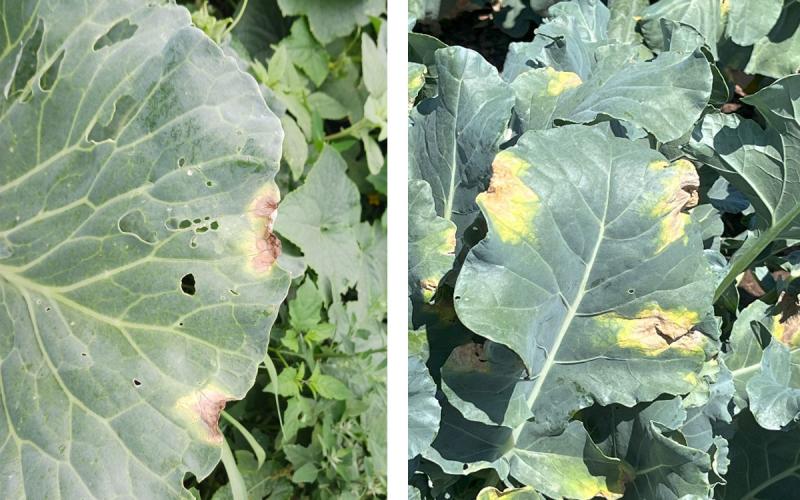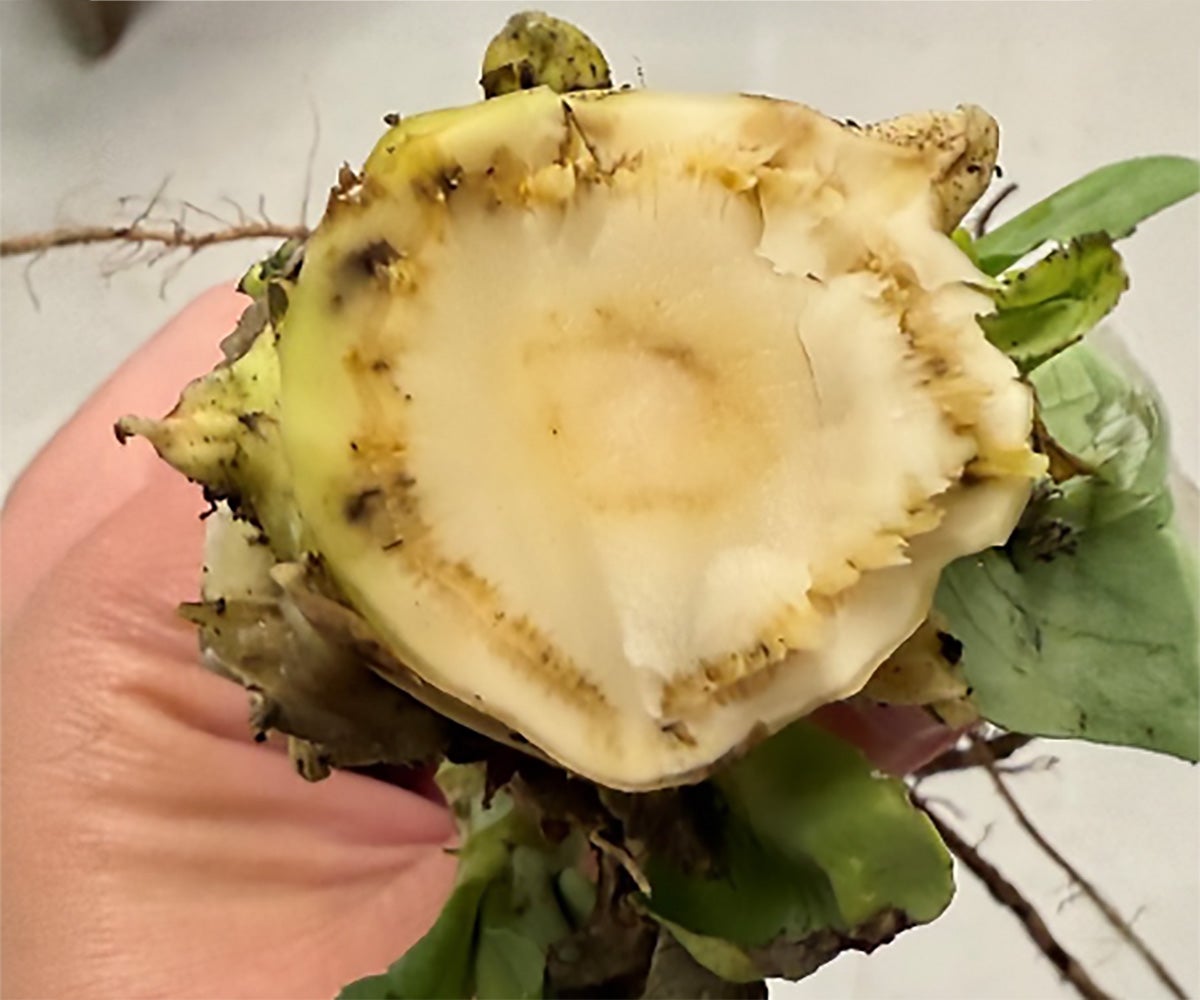Overview
Black rot (Xanthamonas campestris pv. campestris, Xcc) is an uncommon but devastating bacterial disease in South Dakota. Typically, South Dakota’s climate is not conducive to development of this disease, but when periods of hot and wet weather are sustained, it can lead to rapid and widespread crop loss. Black rot can develop at any stage of growth, though it is more commonly seen in the spring on new transplants or late summer. It is most severe on broccoli, cabbage, kale and cauliflower, but can infect all members of the brassica family, including Brussels sprouts, bok choy turnips, kohlrabi, radishes, mustards and others, including forage and ornamental brassica. Bacteria enter pores on the leaf margins, called hydrathodes, through water droplets via splashing, dew condensation, rain or irrigation water. They can also enter through sites of damage from insect feeding, hail, or other mechanical damage to the plant. Black rot can be spread through infected plant residue from the current or previous years. It is also seed-borne. Once a plant is infected, large yellowing and dying lesions will spread down the leaf and eventually result in severe damage or plant death.
Symptoms

Black rot can present differently on various crops. In cauliflower, broccoli, and cabbage and other members of Brassica oleracea, it begins as yellowing wedges on the leaf margins that spread down the leaf (Figure 1). Veins within the affected area will turn brown or black, with leaf tissue surrounding the affected areas turning yellow. Eventually, large portions of the leaf necrose as the disease progresses into the stalk, which will cause head or stalk rot and death of the entire plant (Figure 2). At this stage, stems and stalks will often have black discoloration in the vascular tissue (Figure 3).
In bok choy, turnips, and other members of Brassica rapa, black rot can appear as necrotic speckles on the leaves, which can resemble some leaf spot diseases, but will eventually resemble symptoms on other brassicas and cause head rot and plant collapse as well. Many other soft rots, fungi, and opportunistic pathogens will often colonize the dying plant as well, which can make recognizing this disease difficult.


Management
Black rot is difficult to manage. Xcc can be transmitted by seed into new plantings and can rapidly spread once conditions are favorable. Xcc can survive on decaying plant material and residue for up to 3 years, as well as persist on several weeds in the brassica family, such as shepherd’s purse (Capsella bursa-pastoris). Most management practices focus on reducing Xcc inoculum or minimizing potential introduction of Xcc.
Copper-based sprays or products containing the active ingredient acibenzolar-S-methyl can be used as a preventative but have limited effectiveness. Sprays will not affect the disease once it establishes on a plant. If used, sprays should be timed to prior to and during high-risk conditions of prolonged high humidity and temperature to prevent disease introduction or spread. Avoid excessive use of any copper-based spray to limit the development of resistance in Xcc.
If possible, use drip irrigation or soaker hoses to minimize splashing and avoid overhead watering as much as possible. Purchase certified clean seeds or heat treat seeds to prevent seed transmission of Xcc. To clean seeds of Brussels sprouts, collards, and cabbage, place seeds in hot water (122°F) for 35 minutes. Broccoli, cauliflower, kale, kohlrabi, rutabaga, and turnips only require 20 minutes of the same treatment. Promptly removed infected plant material from the field. Clean tools after working with diseased plants before handling uninfected plants. Increasing spacing between plants can also slow the spread of many diseases, including black rot.
Resistant varieties of many brassica crops are available and have been observed to resist black rot outbreaks in South Dakota. Xcc has been observed to overcome resistance with abundant disease pressure, so it is important to manage black rot outbreaks even with resistant varieties. As Xcc can remain in decaying soil material, rotate infested fields out of any brassica crops for 2 to 3 years to allow inoculum to break down, especially if incorporating residues after harvest. Do not compost infected plants unless similar precautions are taken.
Identification and Diagnostics
Black rot is easily identified by the characteristic triangular necrotic lesions with yellow halos that form on leaf margins. However, as the disease progresses, many other opportunistic pathogens can begin growing on decaying material and can be confused for soft rot (Pseudomonas spp.) and white mold (Sclerotinia spp.) or other bacterial and fungal rots. It can also be confused for fusarium wilt, which lacks the black veins of black rot and also typically only affects one side of the plant. Black rot of brassica is not related to other black rots.
Please send plant disease questions to SDSU Extension Plant Pathology Specialist Dr. Madalyn Shires, SDSU Extension Horticulture Plant Pathology Field Specialist Cody Molnar or SDSU Extension Diagnostician, Connie Tande.
Samples can also be sent to the SDSU Plant Diagnostic Clinic for fee-based diagnostics. The clinic’s mailing address is 1148 Medary Ave, 2207-D, 1451 Stadium Road, Brookings, SD 57007-1090 and the and weekends). For more information, visit the SDSU Plant Diagnostic Clinic website. The physical address for sample drop off is Berg Ag Hall Room 203 (business hours) or 001 (after hours). When collecting and mailing samples, select leaves and plants that include yellowing leaves and mail as quickly as reasonable. Try to keep samples cool but dry; excessive moisture can cause samples to rot while in transit. Samples should be wrapped in a dry paper towel and placed in a closed plastic bag. Please do not send heavily rotting plants.
Sources
- Dániel-Gómez, Mario, Ella Reeves, and Inga M. Meadows. "Practical and comprehensive diagnostic guide for black rot of brassicas." Plant Health Progress 23.3 (2022): 369-375.
- Vicente, Joana G., and Eric B. Holub. "Xanthomonas campestris pv. campestris (cause of black rot of crucifers) in the genomic era is still a worldwide threat to brassica crops." Molecular plant pathology 14.1 (2013): 2-18.
- Hoidal, N. and Schuh, M. 2022. Black Rot of Brassica Crops. University of Minnesota.
- Gevens, Am., Abbrescia, A., Pape, A., Groves, R., and Bradford, B. 2024. Brassica Black Rot. University of Wisconsin.


